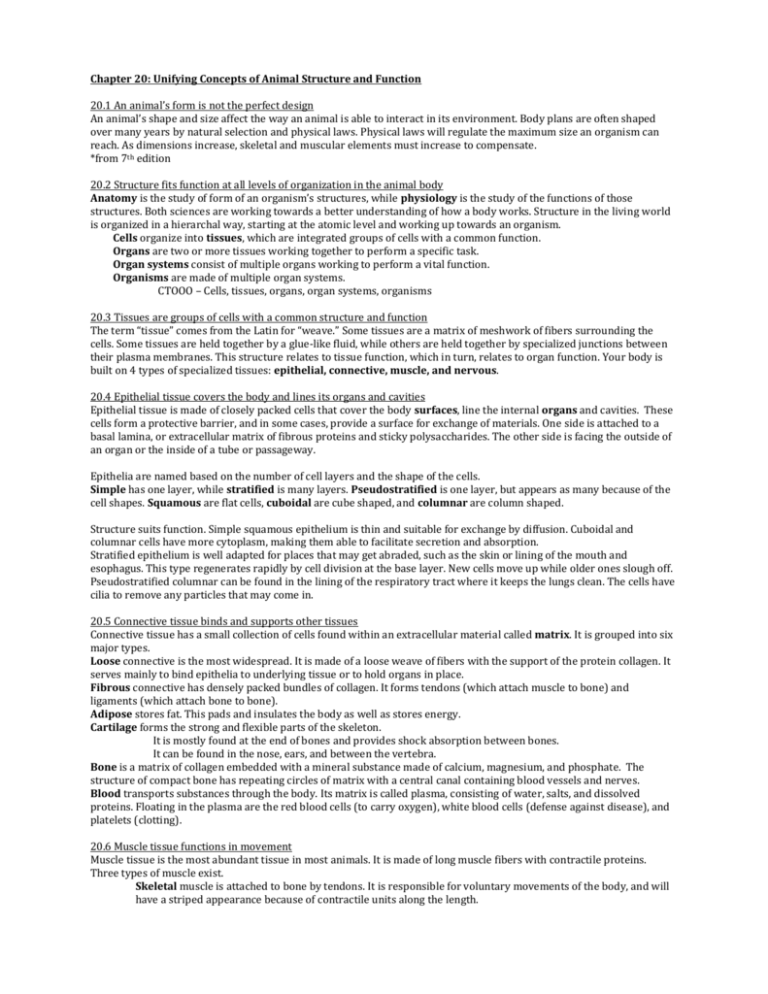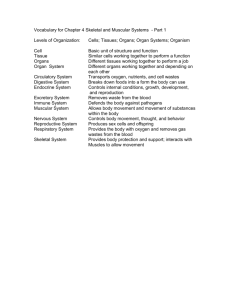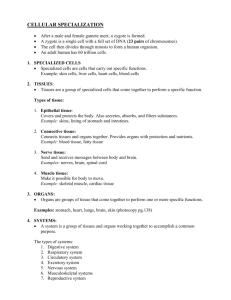Chapter 20: Unifying Concepts of Animal Structure and Function
advertisement

Chapter 20: Unifying Concepts of Animal Structure and Function 20.1 An animal’s form is not the perfect design An animal’s shape and size affect the way an animal is able to interact in its environment. Body plans are often shaped over many years by natural selection and physical laws. Physical laws will regulate the maximum size an organism can reach. As dimensions increase, skeletal and muscular elements must increase to compensate. *from 7th edition 20.2 Structure fits function at all levels of organization in the animal body Anatomy is the study of form of an organism’s structures, while physiology is the study of the functions of those structures. Both sciences are working towards a better understanding of how a body works. Structure in the living world is organized in a hierarchal way, starting at the atomic level and working up towards an organism. Cells organize into tissues, which are integrated groups of cells with a common function. Organs are two or more tissues working together to perform a specific task. Organ systems consist of multiple organs working to perform a vital function. Organisms are made of multiple organ systems. CTOOO – Cells, tissues, organs, organ systems, organisms 20.3 Tissues are groups of cells with a common structure and function The term “tissue” comes from the Latin for “weave.” Some tissues are a matrix of meshwork of fibers surrounding the cells. Some tissues are held together by a glue-like fluid, while others are held together by specialized junctions between their plasma membranes. This structure relates to tissue function, which in turn, relates to organ function. Your body is built on 4 types of specialized tissues: epithelial, connective, muscle, and nervous. 20.4 Epithelial tissue covers the body and lines its organs and cavities Epithelial tissue is made of closely packed cells that cover the body surfaces, line the internal organs and cavities. These cells form a protective barrier, and in some cases, provide a surface for exchange of materials. One side is attached to a basal lamina, or extracellular matrix of fibrous proteins and sticky polysaccharides. The other side is facing the outside of an organ or the inside of a tube or passageway. Epithelia are named based on the number of cell layers and the shape of the cells. Simple has one layer, while stratified is many layers. Pseudostratified is one layer, but appears as many because of the cell shapes. Squamous are flat cells, cuboidal are cube shaped, and columnar are column shaped. Structure suits function. Simple squamous epithelium is thin and suitable for exchange by diffusion. Cuboidal and columnar cells have more cytoplasm, making them able to facilitate secretion and absorption. Stratified epithelium is well adapted for places that may get abraded, such as the skin or lining of the mouth and esophagus. This type regenerates rapidly by cell division at the base layer. New cells move up while older ones slough off. Pseudostratified columnar can be found in the lining of the respiratory tract where it keeps the lungs clean. The cells have cilia to remove any particles that may come in. 20.5 Connective tissue binds and supports other tissues Connective tissue has a small collection of cells found within an extracellular material called matrix. It is grouped into six major types. Loose connective is the most widespread. It is made of a loose weave of fibers with the support of the protein collagen. It serves mainly to bind epithelia to underlying tissue or to hold organs in place. Fibrous connective has densely packed bundles of collagen. It forms tendons (which attach muscle to bone) and ligaments (which attach bone to bone). Adipose stores fat. This pads and insulates the body as well as stores energy. Cartilage forms the strong and flexible parts of the skeleton. It is mostly found at the end of bones and provides shock absorption between bones. It can be found in the nose, ears, and between the vertebra. Bone is a matrix of collagen embedded with a mineral substance made of calcium, magnesium, and phosphate. The structure of compact bone has repeating circles of matrix with a central canal containing blood vessels and nerves. Blood transports substances through the body. Its matrix is called plasma, consisting of water, salts, and dissolved proteins. Floating in the plasma are the red blood cells (to carry oxygen), white blood cells (defense against disease), and platelets (clotting). 20.6 Muscle tissue functions in movement Muscle tissue is the most abundant tissue in most animals. It is made of long muscle fibers with contractile proteins. Three types of muscle exist. Skeletal muscle is attached to bone by tendons. It is responsible for voluntary movements of the body, and will have a striped appearance because of contractile units along the length. Cardiac muscle forms the contractile muscle of the heart. It is striped (striated) like skeletal muscle. It is under involuntary control and you cannot control the contractions. Smooth muscle does not have striations. It is found in the walls of the digestive tract, arteries, and internal organs. It is also involuntary, controlling activities like moving substances through the body. 20.7 Nervous tissue forms a communication network Nervous tissue senses stimuli and transmits the information. The functional unit is the nerve cell, neuron. Nervous tissue has many supporting cells; some surround and insulate axons, others help nourish and regulate the fluid around them. 20.8 Organs are made of tissue Tissues are arranged into organs that have specific function. An organ is able to perform functions that its component tissues cannot carry out alone. These functions only come form coordinated action of many tissues. 20.9 Bioengineers are learning to produce organs for transplants Eighty people per day receive an organ transplant in the US, while 20 others die waiting. If scientists could create a scaffold on which to build organs, then they could produce working organs. This was done with the bladder being built on a balloon like scaffold. Many of these have been successfully transplanted. If other scaffolds could be designed, then organs could be grown from patient cells to prevent rejection. 20.10 Organ systems work together to perform life’s functions It takes the integration of several organs to perform the body’s functions. 20.11 The integumentary system protects the body Structure of the skin: The skin is made of two distinct layers, the epidermis and dermis. The epidermis is made of stratified squamous epithelium. Rapid cell division at the base replenishes the upper layers constantly. They will replenish enough that the epidermis is replaced every few weeks. The dermis is made of dense connective tissue with elastic fibers and strong collagen fibers. It contains hair follicles, oil and sweat glands, muscles, nerves, sensory receptors, and blood vessels. Under the dermis is the hypodermis, or layer of adipose. Functions of skin: It provides waterproofing that resists dehydration and prevents entry of microbes. Sensory receptors check for temperature and then help regulate that temperature. Another metabolic function of skin is the production of vitamin D, which allows for calcium absorption. Hair and nails: Hair is a collection of keratin filled dead cells produced by the hair follicle. Oil glands lubricate the hair, condition the surrounding skin, and inhibit bacterial growth. Hair insulates the bodies of most animals, while it is limited to the head of humans. Fingernails and toenails are protective coverings made of keratin. 20.12 Well-designed studies help answer scientific questions Good experiments involve a control group and test only one variable at a time 20.13 Structural adaptations enhance exchange with the environment Every living organism exchanges matter and energy with its surroundings. The exchange of materials with the environment must extend to the cellular level. Exchange of gases, nutrients, and wastes occur via aqueous solutions. These materials will be dissolved in the solution and move across the plasma membrane of a cell. 20.14 Animals regulate their internal environment There are two environments that are critical to an animal: the external environment and the internal environment. Many animals maintain a constant internal environment. This maintenance of a constant internal environment is called homeostasis. Conditions in the external environment may be erratic, but the internal system will maintain a steady state 20.15 Homeostasis depends on negative feedback Most of the control methods of homeostasis are regulated by negative feedback. In this, a change triggers the mechanisms that reverse the change.






